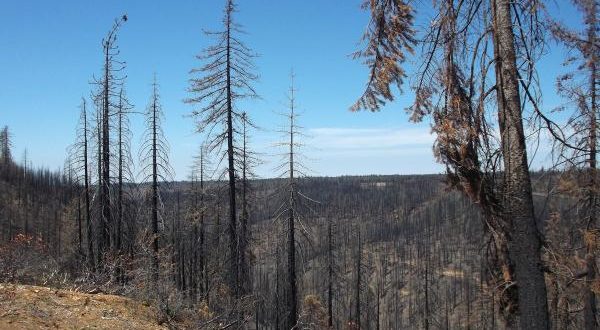Drought-empowered bug infestations killing trees in Sierra
Published on June 17th, 2015
Tim Hearden
June 16, 2015
Capital Press
Drought conditions in the Sierra Nevada are leading to bug infestations that are killing millions of trees, according to a University of California Cooperative Extension adviser.
Drought is taking a toll on California forest lands, weakening trees and making them more susceptible to deadly attacks from pests, according to a university study.
U.S. Forest Service aerial monitoring surveys in 2015 showed a large increase in tree mortality in the southern Sierra Nevada, as an estimated 10 million dead trees were spotted in more than 4.1 million acres of public and private land, according to the University of California’s Division of Agriculture and Natural Resources.The lack of water is leaving trees without the pitch necessary to prevent beetles from burrowing into the tree through the bark, leading to an infestation that overcomes the tree, explained Susie Kocher, a UC Cooperative Extension advisor.
The best defense is to space trees widely enough to give them more access to resources and thinning the forest to reduce overcrowding, Kocher wrote in a report on the UC’s website.
Sierra Pacific Industries spokesman Mark Pawlicki said the company is encountering stressed trees on its land and agrees that forest thinning is a solution.
“The answer is to remove the dead and dying trees and continue to try to keep the remaining trees healthy by avoiding over-stocking,” Pawlicki said in an email. “And pray for rain!”
While the dry conditions make it harder for companies to receive the go-ahead to initiate logging projects in some instances, widespread bug infestations could further complicate matters for a timber industry that is still one of the mountain region’s leading agricultural industries, generating $128.4 million in value in 2013, according to a California State University-Chico study.
As forests remain dry, thinning projects become more difficult, timber professionals have said.
“We’re absolutely going to lose some time this summer because of the fire danger,” Larry Strawn, owner of Redding, Calif-based Blue Ridge Forest Management, said recently.
One of the main culprits killing pines in the Sierra is the western pine beetle, which bore into ponderosa pines, lay eggs which develop into larvae in the inner bark and then complete development in the outer bark, Kocher wrote.
In the Stanislaus National Forest, areas with dead trees have doubled since last year, and more than 5 million trees were killed in the Sierra and Sequoia national forests — up from about 300,000 trees killed in the same area last year, she reported.
The report comes after UC-Merced researchers said in May that increasing projects to thin trees and clear brush from forest floors could boost water yields from mountain forests by as much as 10 percent.





